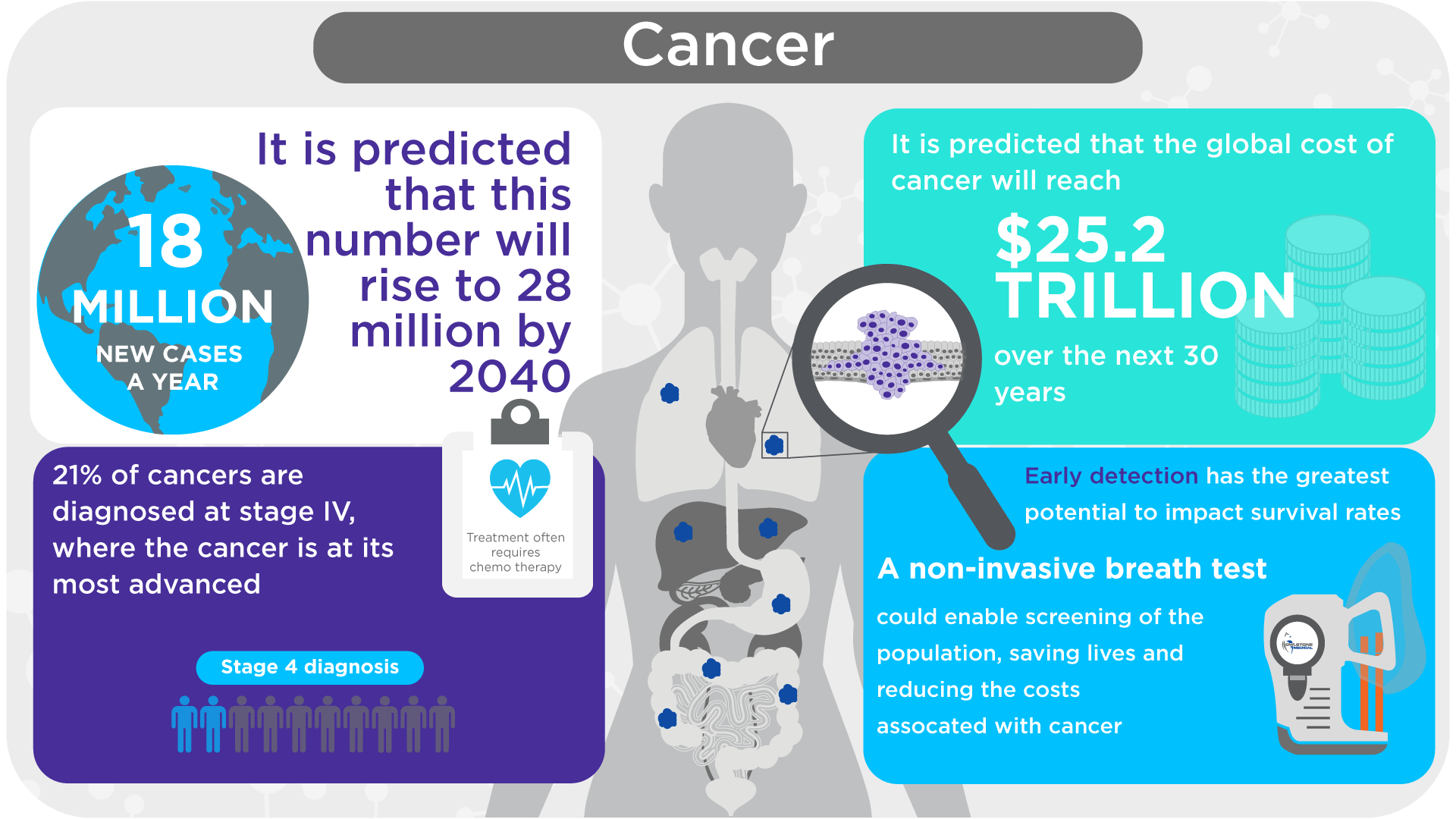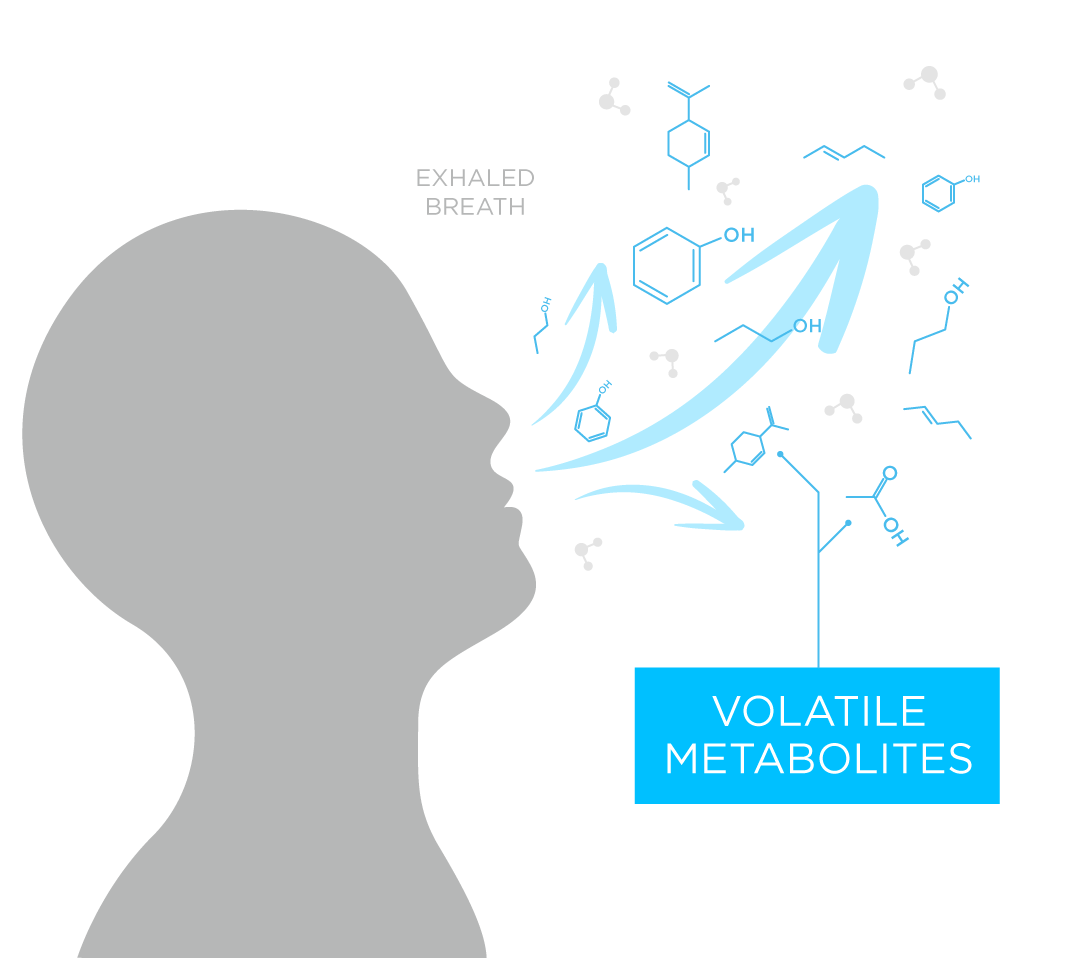Cancer and Breath Analysis: What can VOCs show?
Published on: 25 Mar 2024
There are numerous challenges associated with cancer management, including delayed diagnosis, low efficacy of anti-cancer therapy, and heterogeneity of disease. The sensitivity of the most common imaging techniques currently used to diagnose cancer (CT, MRI, and PET scans) depends highly on tumor size, meaning it is hard to achieve an early diagnosis for patients in the beginning stages of the disease.
These techniques are also costly and are not viable for widespread screening due to time inefficiency. Scans cannot provide accurate cancer staging, and therefore invasive procedures such as bronchoscopy, blood tests, and endoscopic ultrasounds are needed (1). Histological biopsy is the gold standard for cancer diagnosis, however, it is invasive, time-consuming, and expensive. There is an urgent need for inexpensive and non-invasive diagnostics that would allow:
- Early detection of cancer.
- Stratification of patients for personalized therapy.
- Assessment of treatment efficacy.
Volatile organic compounds (VOCs) in the breath have been associated with the pathophysiology of cancers, so it is suspected that changes in the levels of VOCs could be used as biomarkers for cancer, even in the early stages. VOCs are produced by healthy cells through metabolic processes, but in cancer patients, these processes are altered which can lead to differing levels of these VOCs.
Oxidation of fatty acids generates acetyl COA that can enter the Krebs cycle. Cancer cells exhibit altered glucose metabolism known as the Warburg effect in which their energy production shifts from the Krebs cycle to glycolysis. Therefore, acetone and other ketone bodies can be produced from excess acetyl COA. Acetone and ketones are VOCs, meaning they can be measured non-invasively in breath.
Cancer development is linked to increased oxidative stress, which can generate VOCs such as alkanes and aldehydes that can be measured in exhaled breath (2). As VOCs can reflect cancer-related metabolism, they could indicate specific genetic mutations that could determine how responsive patients may be to treatment (3). Therefore, VOCs could provide an avenue for biomarkers in cancer research, and breath analysis could be a non-invasive method for the diagnosis of cancer.
VOCs that are associated with cancer.
Lung cancer.
Studies have found many different VOCs in the breath that can differentiate between lung cancer patients and healthy controls. One study found that ethyl acetate, geranylacetone, 2-undecanone, acetic acid, 2-heptanone, oxepane, and cyclopentanone could detect lung cancer patients with an accuracy of 92% (4). The concentrations of these VOCs could also discriminate patients with lung cancer from healthy controls and smokers.
Another study aimed to identify breath biomarkers of lung cancer through breath testing, where the breath of 84 patients with lung cancer were analyzed before and after surgery to remove the tumor. This led to the identification of 16 VOCs that significantly changed in abundance in the breath after surgery as candidate lung cancer biomarkers, and 15 VOCs showed a significant reduction post-surgery, including isoprene, pentanal, and hexanal (5). Over 100 VOCs have been proposed as being linked to lung cancer in the last 10 years (6).
At Owlstone Medical our clinical trial EVOLUTION is investigating the diagnostic potential of D5-ethyl-βD-glucuronide as an exogenous volatile organic compound (EVOC®) probe for the detection of lung cancer. Our EVOC probe method is a reliable and highly sensitive alternative to untargeted biomarker discovery. This approach offers the advantage that compounds not normally found at significant levels in breath can be introduced into the body to explore how they are absorbed, metabolized, or excreted.
As breath is a sampling medium that is in constant contact with the lungs, analysis of breath can provide a direct insight into lung cancer as opposed to blood or other diagnostics methods that are more indirect.
Breast cancer.
Breast cancer patients can be identified from healthy individuals using breath analysis and the identification of VOCs. Aldehydes such as hexanal, heptanal, octanal, nonanal, and methanal are just a few examples of VOCs that could be biomarkers for breast cancer (7). Another study reported five compounds observed in various concentrations in the breath of breast cancer patients including 3-methylhexane, dec-1-ene, caryophyllene, naphthalene, and trichloroethene as potential biomarkers (8).
Due to the close proximity between the breasts and the lungs, VOCs that originate from breast cancer can diffuse through local blood vessels straight into the lungs and be exchanged into the air and be exhaled in breath.
Prostate and bladder cancer.
Methanal has been proposed as a possible biomarker for prostate and bladder cancer (9).
Studies have found that protein biomarkers for bladder urothelial tumors can be found in the blood (10). VOCs from the bladder can also enter the blood, travel around the body, diffuse into the lungs, and be exhaled in breath.
Liver cancer.
VOCs such as decane, styrene, and 3-hydroxybutan-2-one, have been measured in the breath of liver cancer patients and can be used to distinguish between patients and healthy controls (11).
Due to the highly vascular nature of the liver, VOCs originating from liver cancer can readily enter the blood stream, travel around the body, diffuse into the lungs, and be exhaled in breath.
Gastric cancer.
Many studies have been performed to identify potential VOC biomarkers to diagnose gastric cancers. One study found eight VOCs including 2-propenenitrile, furfural, 2-butoxyethanol, hexadecane, 4-methyl octane, 1,2,3-tri-methylbenzene, α-methyl-styrene, and 2-butanone in the exhaled breath of patients with stomach malignancies (12). Another study also found 12 VOCs, mainly alcohols and aldehydes, in significantly higher concentrations in the exhaled breath of gastric cancer patients compared to healthy controls (13).
It has been discovered that the time-lag between bacteria in the gastrointestinal tract producing hydrogen, and detectable levels of hydrogen appearing in the breath is five minutes or less (14). Therefore it can be hypothesized that gastric cancer originating VOCs can provide real-time measurements for early stage cancers.
Many more cancers produce VOCs that can be measured in the breath. However, it remains to be seen whether these VOCs are general markers of cancer metabolism or whether some could display more specificity for different cancer types.
Breath analysis can support cancer research.
VOCs that originate from cancer-specific metabolism can readily enter our lungs and be exhaled from the body in the breath. These compounds can be analyzed in breath and can provide insight into the development and prognosis of cancer. Breath is a virtually inexhaustible resource, with large volumes able to be collected at frequent intervals, meaning breath analysis can provide an almost real-time longitudinal analysis of VOCs. The non-invasive nature of breath analysis makes it more attractive than techniques such as biopsies where damage can occur to the surrounding tissue and can be uncomfortable for the patient.
We are the world leaders in breath research for the early detection of disease, which is crucial in the fight against cancer. We are here to help you include breath analysis in your research. Breath Biopsy OMNI can provide everything you might need to start or continue using breath analysis, and you can receive expert advice from our team of scientists. You can cross-check your data against our VOC Atlas to better understand how VOCs behave in a healthy population and confidently validate your cancer biomarkers. You can get in touch with our experts to discuss how our technology can be incorporated into your biomarker discovery workflow.
References.
- Einoch Amor R, Nakhleh MK, Barash O, Haick H. Breath analysis of cancer in the present and the future. Eur Respir Rev Off J Eur Respir Soc. 2019 Jun 30;28(152):190002. DOI: 10.1183/16000617.0002-2019
- Ratcliffe N, Wieczorek T, Drabińska N, Gould O, Osborne A, Costello BDL. A mechanistic study and review of volatile products from peroxidation of unsaturated fatty acids: an aid to understanding the origins of volatile organic compounds from the human body. J Breath Res. 2020 May;14(3):034001. DOI: 10.1088/1752-7163/ab7f9d
- Schmidt K, Podmore I. Current Challenges in Volatile Organic Compounds Analysis as Potential Biomarkers of Cancer. J Biomark. 2015 Mar 30;2015:e981458. DOI: 10.1155/2015/981458
- Rai SN, Das S, Pan J, Mishra DC, Fu XA. Multigroup prediction in lung cancer patients and comparative controls using signature of volatile organic compounds in breath samples. PLOS ONE. 2022 Nov 30;17(11):e0277431. DOI: 10.1371/journal.pone.0277431
- Wang P, Huang Q, Meng S, Mu T, Liu Z, He M, et al. Identification of lung cancer breath biomarkers based on perioperative breathomics testing: A prospective observational study. EClinicalMedicine. 2022 May;47:101384. DOI: 10.1016/j.eclinm.2022.101384
- Sharma A, Kumar R, Varadwaj P. Smelling the Disease: Diagnostic Potential of Breath Analysis. Mol Diagn Ther. 2023 May 1;27(3):321–47. DOI: 10.1007/s40291-023-00640-7
- Li J, Peng Y, Liu Y, Li W, Jin Y, Tang Z, et al. Investigation of potential breath biomarkers for the early diagnosis of breast cancer using gas chromatography–mass spectrometry. Clin Chim Acta. 2014 Sep 25;436:59–67. DOI: 10.1016/j.cca.2014.04.030
- Mangler M, Freitag C, Lanowska M, Staeck O, Schneider A, Speiser D. Volatile organic compounds (VOCs) in exhaled breath of patients with breast cancer in a clinical setting. Ginekol Pol. 2012 Oct;83(10):730–6.
- Španěl P, Smith D, Holland TA, Singary WA, Elder JB. Analysis of formaldehyde in the headspace of urine from bladder and prostate cancer patients using selected ion flow tube mass spectrometry. Rapid Commun Mass Spectrom. 1999;13(14):1354–9. DOI: 10.1002/(SICI)1097-0231(19990730)13:14<1354::AID-RCM641>3.0.CO;2-J
- López-Cortés R, Gómez BB, Vázquez-Estévez S, Pérez-Fentes D, Núñez C. Blood-based protein biomarkers in bladder urothelial tumors. J Proteomics. 2021 Sep 15;247:104329. DOI: 10.1016/j.jprot.2021.104329
- Qin T, Liu H, Song Q, Song G, Wang H zhi, Pan Y yin, et al. The Screening of Volatile Markers for Hepatocellular Carcinoma. Cancer Epidemiol Biomarkers Prev. 2010 Sep 8;19(9):2247–53. DOI: 10.1158/1055-9965.EPI-10-0302
- Amal H, Leja M, Funka K, Skapars R, Sivins A, Ancans G, et al. Detection of precancerous gastric lesions and gastric cancer through exhaled breath. Gut. 2016 Mar 1;65(3):400–7. DOI: 10.1136/gutjnl-2014-308536
- Kumar S, Huang J, Abbassi-Ghadi N, Mackenzie HA, Veselkov KA, Hoare JM, et al. Mass Spectrometric Analysis of Exhaled Breath for the Identification of Volatile Organic Compound Biomarkers in Esophageal and Gastric Adenocarcinoma. Ann Surg. 2015 Dec;262(6):981. DOI: 10.1097/SLA.0000000000001101
- Read NW, Al-Janabi MN, Bates TE, Holgate AM, Cann PA, Kinsman RI, et al. Interpretation of the breath hydrogen profile obtained after ingesting a solid meal containing unabsorbable carbohydrate. Gut. 1985 Aug;26(8):834–42. DOI: 10.1136/gut.26.8.834

